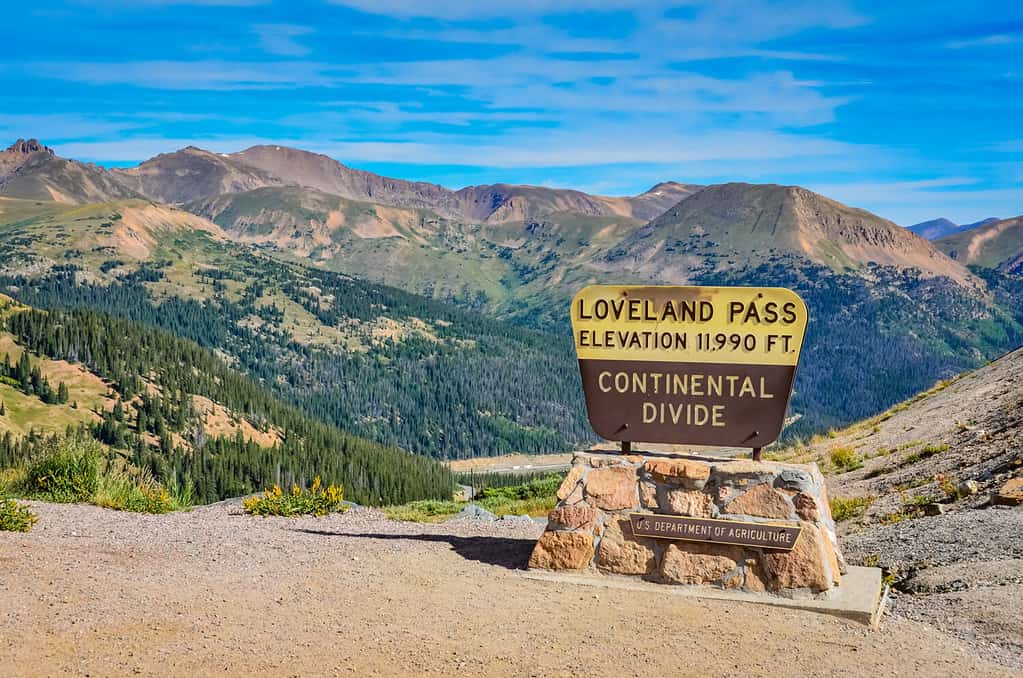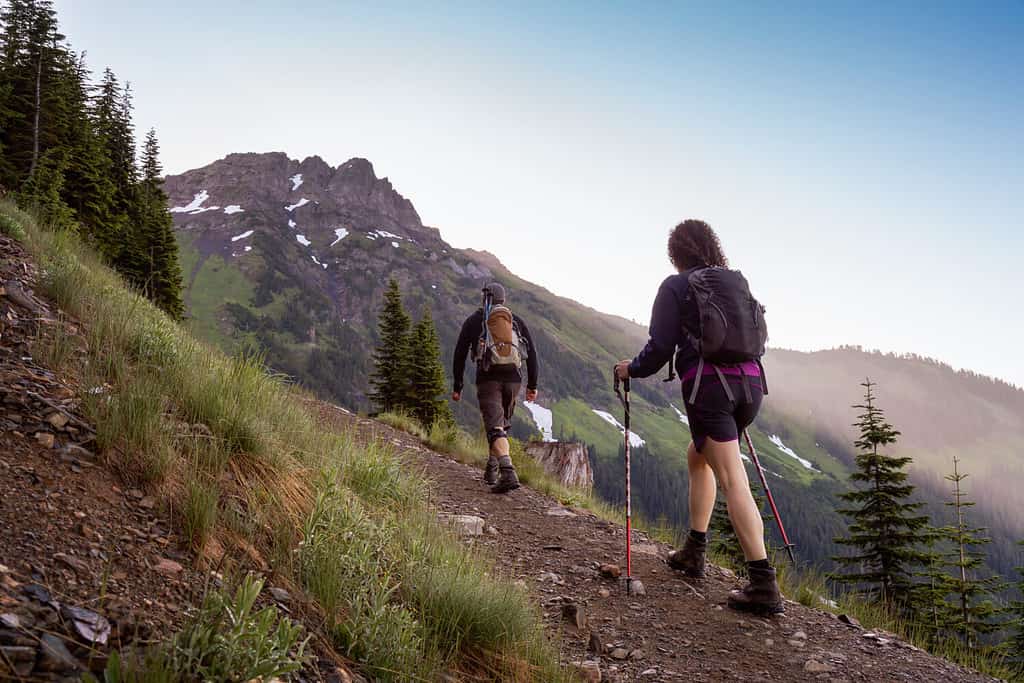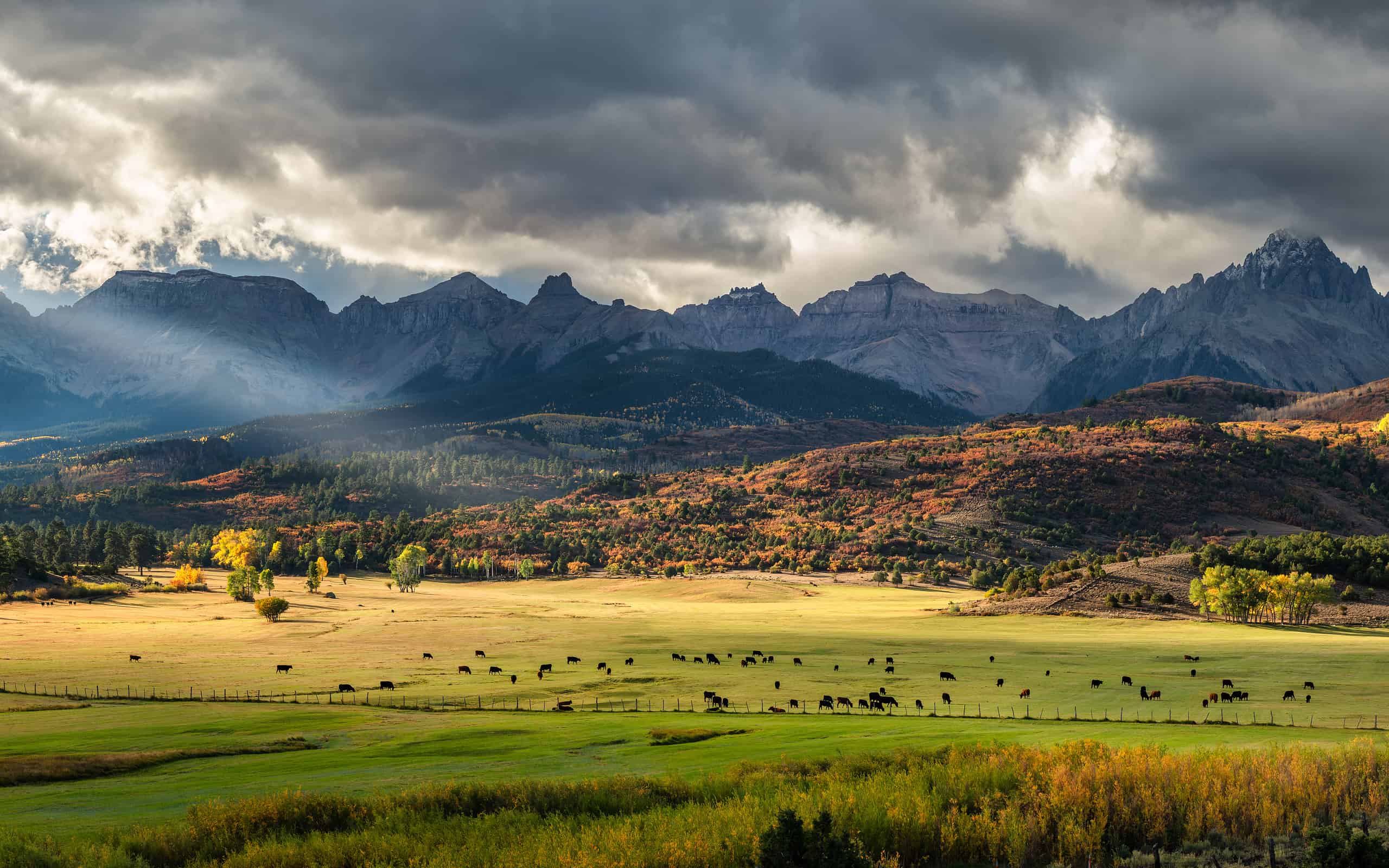You have heard of famous peaks like Mount Fuji and the Himalayas. But what about one of America’s own impressive but lesser-known peaks? Grizzly Peak is an astonishing summit found in the Rocky Mountains of North America. So, what is the height of Grizzly Peak? Grizzly Peak is a whopping 13,988 feet in elevation. Even though this is almost an unimaginable height, it’s not even the tallest peak in this mountain range! Keep reading to learn more about Grizzly Peak and other impressive pinnacles in the United States.

You can get to Grizzly Peak from the east side of Loveland Pass.
©Sandra Foyt/Shutterstock.com
Where is Grizzly Peak?
Grizzly Peak is located in the Rocky Mountains. It sits along the Continental Divide, which separates North America’s river systems feeding into different large bodies of water. There is a much smaller Grizzly Peak located in Berkeley Hills, California. This peak is only 1,759 feet in elevation.
Though it is named “Grizzly Peak” there are supposedly not any more wild grizzly bears in Colorado. Black bears, however, are common. Other animals you might encounter on your day-hike are moose, bighorn sheep, and plenty of birds of prey.
How Long is a Hike Around Grizzly Peak?
The Grizzly Peak hike can take around five hours to do in a round-trip for experienced hikers. It’s also available to drive, which will take around one hour. It’s not often camped at since it is a doable day hike, though there are plenty of areas nearby to set up a campsite for a few nights.
Since it is a challenging hike, those who proceed with this adventure should be prepared.
Hiking Necessities

Hiking Grizzly Peak can be done any time of the year, though in winter the trail may not be easy to follow.
©EB Adventure Photography/Shutterstock.com
Even if you’re only planning on being out for a day trip, it’s essential to take the necessary precautions when you’re out in the wilderness.
Water and water purification tools, like a LifeStraw, should always be integral parts of your hiking pack. In the case of an emergency, staying hydrated will be key to survival. Likewise, keeping food in the form of protein bars, dried fruits or jerky, or dehydrated meals can also come in handy. Having a way to start fire is also a good idea.
A first aid kit and navigation system, such as a compass and map, should also be part of your pack. A compass and map of the area will help you navigate areas that have downed trees or other obstacles which you have to maneuver around. A first aid kit can help patch up minor cuts, scrapes, or wounds one might encounter while out in the wild.
Wearing the appropriate clothes and shoes for the terrain and weather is of utmost importance. Having a base layer of warm clothing can help you maintain a comfortable temperature. Grizzly Peak is high in elevation so it’s going to be cooler at the peak of the mountain than in the areas below. By wearing layers, you can always remove one if you get too warm.
Hiking poles are also a useful tool to have. These can help with testing the safety of a rock or other terrain and also can help with your balance and ability to scale steep hills.
Inclement Weather and Wildfire Preparation
Whenever mountain ranges are concerned, you should always be ready for unpredictable weather. Due to how tall Grizzly Peak is, it is often covered in snow. But thunderstorms or dry conditions leading to wildfires are still possible. While it’s always best practice to check the weather before you embark on a height, weather in the mountains can take a turn very quickly.
For storms, lightning is a major threat. Make sure you stay at least 100 feet away from any metal hiking poles or other sources of metal during this time. If you can, seek shelter from the elements. Partially covered trail shelters or other structures are unfortunately not the safest. If you can’t find shelter, sit on the balls of your feet with your head down and covered.
If a wildfire happens to start while you’re outside, you must clear the area you’re near of fuel for the fire. This includes litter, sticks, and other debris that can easily ignite. Ideally, you should find a depression to seek shelter. Lay flat, face down and try to cover yourself something to protect yourself from the heat. If you’re near a road you should lay along the road cut. Of course, if you’re close enough to your vehicle to drive out of harm’s way (without going towards the fire) that is the first course of action you should take.
What is the Tallest Peak in Colorado?
13,988 feet tall for a mountain is nothing to sneeze at. However, Colorado is home to some mountains that are hundreds of feet taller than Grizzly Peak. The tallest peak in Colorado is Mount Elbert which measures 14,439 feet. This summit is located in the Sawatch ranges of the Rockies, which is also where Grizzly Peak is located.
The second tallest is Mount Massive. This impressive peak is 14,429 feet tall and is also in the Sawatch Range. There are 58 peaks in Colorado that are over 14,000 feet tall and over 600 that are over 13,000 feet tall. Mountains of these heights are affectionately called “14ers” and “13ers” by locals and tourists. Grizzly Peak has earned the title of the highest “13er” in Colorado.
How Does Grizzly Peak Compare to Other Well-Known U.S. Peaks?

Denali was the first national park established with the specific goal of protecting wildlife.
©JoAnn Campbell/iStock via Getty Images
Colorado is home to plenty of 13,000 and 14,000+ feet summits, but there are even more monumental ones if you expand the scope to the rest of the US.
The highest peak in the United States is Denali in Alaska. You might be more familiar with this mountain by its other name “Mount McKinley”. Its height easily dwarfs that of Grizzly Peak: Denali is 20,310 feet above sea level. The rich ecosystem of the mountain and gorgeous views attracts swaths of naturalists and hikers alike with its unmatched landscapes and views.
Some other well-known peaks in the U.S. include Mount Saint Elias which is 18,008 feet tall and also in Alaska. Mount Rainier is 14,410 feet tall and is an active volcano in Washington state. Though it is much smaller than the other two mountains listed, it’s a celebrated peak and is just barely taller than Grizzly Peak. Mount Rainier is also the area which five major rivers spawn from due to the large amounts of ice sheets present on the mountain.
Mount Washington, another familiar peak, is not in Washington at all. It is in New Hampshire and boasts the title of the highest peak in northeastern U.S. The summit of this mountain is only 6,288 feet tall, which is under half the height of Grizzly Peak. Still, this popular mountain grants access to some gorgeous northeastern sites. On a clear day, one can see straight to Quebec.
Thank you for reading! Have some feedback for us? Contact the AZ Animals editorial team.








